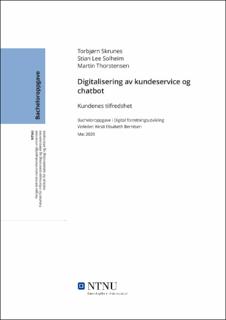| dc.contributor.advisor | Berntsen, Kirsti Elisabeth | |
| dc.contributor.author | Skrunes, Torbjørn | |
| dc.contributor.author | Solheim, Stian Lee | |
| dc.contributor.author | Thorstensen, Martin | |
| dc.date.accessioned | 2020-08-16T16:02:20Z | |
| dc.date.available | 2020-08-16T16:02:20Z | |
| dc.date.issued | 2020 | |
| dc.identifier.uri | https://hdl.handle.net/11250/2672187 | |
| dc.description.abstract | Formålet med bacheloroppgaven er å utforske hvordan virksomheter digitaliserer og benytter seg av digitale funksjoner. Vi ser nærmere på digitalisert kundeservice, og undersøker hvordan kunder opplever den digitale kundeservicen som er tilgjengelig i dag. Vi måler og analysere opplevd kundetilfredshet knyttet til bruk av chatbot og annen digitalisert kundeservice, samtidig som vi identifiserer hvilke faktorer som er viktige å fokusere på.
Vi har gjennomført en spørreundersøkelse og et dybdeintervju for å besvare problemstillingen: Kundetilfredshet ved bruk av chatbots og annen digitalisert kundeservice. Hva opplever kundene?. De endelige funnene sier at faktorene pålitelighet, respons og tillit fører til en positiv opplevelse for kundene ved bruk av chatbot. Faktorene empati, kommunikasjon og kunnskap fører derimot til en negativ opplevelse for kundene. I metodekapittelet presenterer vi et utvidet rammeverk som bygger på “Service Quality Model”. Fra intervjuet ser vi at betydelige ressurser blir benyttet for å videreutvikle og kvalitetssikre det digitale tilbudet for kundene.
Vi konkluderer med at chatbot kan være en god start for enkle spørsmål, eller for å bistå som en veileder for kundene. Det kommer også frem at kundene ofte må benytte menneskelig hjelp for å få svar på det de lurer på. Vi ser et stort potensial for chatbot i fremtiden, men at det fortsatt er et stykke igjen før den klarer å utkonkurrere menneskelige interaksjon. | |
| dc.description.abstract | The purpose of this bachelor thesis is to explore how businesses are making the switch to a digital world in order to enhance their clients’ consumer experience by prioritizing digitalized customer services. In this document we take a closer look at the processes that currently exist and investigate how consumers are currently using these services and try to uncover some of the key pain points. We are able to measure and analyze the consumers by using surveys and interviews.
When deciding which research methods to implement, we decided on a survey plus an in-depth interview. Using these methods, we hope to answer the following questions: How are consumers using and enjoying the new digitalized customer service options? Are they satisfied with an online experience, and what else could be added to ensure consumers are fully satisfied and are able to accomplish what they need using these newer services?
From the research conducted, we were able to conclude that consumers gravitate towards using a chatbot because of the reliability, response time, and security. Additionally, we discovered a number of customer pain points such as a lack of empathy, communication, and knowledge. We found that these pain points deter customers from wanting to use the chatbot. In the method chapter, we present an extended framework based on the “Service Quality Model”. From the interview, we see that significant resources are being used to ensure that consumers are content with the quality of the chatbot service, and to further develop the online experience with the user in mind.
We conclude that the chatbot can be a good start for simple questions or can assist as a guide for customers. It was evident from the research and the data we collected, that consumers often need additional help and information even after using the chatbot. This demonstrates that there is still a great need for human resources to aid consumers with their questions. We see great potential for digital customer services in the future, however there are still many levels of improvement that can be made before it manages to outperform human based interactions. | en |
| dc.publisher | NTNU | |
| dc.title | Digitalisering av kundeservice og chatbot
- Kundens tilfredshet | |
| dc.type | Bachelor thesis | |
